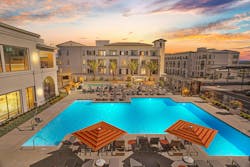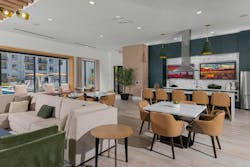This article first appeared in the May/June 2025 issue of Pro Builder.
When a home builder reports a year-over-year revenue increase of 212%, from about $83 million to more than $258 million—a leap that propels the company 80 places higher in our annual Top 200 rankings—it gets our attention. So, we reached out to Nick Lee, COO of Newport Beach, Calif.-based Baldwin & Sons to get some insights into the company’s dramatic climb in revenue (and completions) last year, and how the builder-developer manages its build-to-rent strategy in the mid-rise multifamily sector.
A diversified company founded in 1956, Baldwin & Sons entered the multifamily sector in 2016. Its Enclave brand of mid-rise apartments can be found in Otay Ranch, a 5,300-acre, mixed-use planned community it developed in Chula Vista, Calif., and in others nearby, with more to come. “It’s essential to offer a diverse mix of housing types,” says Lee.
Pro Builder: What market factors are driving your growth in the multifamily rental sector?
Nick Lee: We’re seeing significant growth driven by pent up demand, particularly in the Otay Ranch submarket, which has experienced limited multifamily development. Additionally, we acquired land at a low basis, already entitled for this level of density, positioning us well to capitalize on market needs.
PB: How competitive is the multifamily rental sector in your market?
NL: Otay Ranch consistently maintains low vacancy rates and strong demand, driven by its proximity to major employment hubs, top-rated schools, and ongoing infrastructure investments.
The continuous delivery of high-amenity, mid-density multifamily communities that integrate retail spaces and urban characteristics with suburban convenience further intensifies competition.
People from across San Diego County are drawn to Otay Ranch’s high quality of life. The market’s stable performance underscores its long-term strength and positive growth trajectory.
PB: How and why has that landscape changed in the last 2-5-10 years?
NL: Over the past 10 years, Southern California—including Otay Ranch—has experienced supply constraints, which have created ongoing housing demand for both workforce and lifestyle-oriented housing, resulting in compressed vacancy rates and supporting the rise of mid- and high-density, mixed-use developments.
In the past 5 years, Otay Ranch has evolved into a lifestyle-focused corridor. New multifamily developments have introduced an urban-inspired residential experience within the suburban community. Walkability, design sophistication, integrated retail and modern amenities make the area particularly attractive.
Over the last 2 years, despite the ongoing release of new units, vacancy rates have remained consistently below 5%, reflecting strong demand and sustained renter interest. Otay Ranch continues to draw tenants from across the region, thanks to its master-planned layout, expanding amenities, and reputation as a high-quality, livable community.
PB: What percentage of your overall revenue does the multifamily rental sector account for?
NL: It varies over time. Our revenue mix fluctuates depending on the balance between for-sale and for-rent product at any given point. Currently, we’re heavier on the for-rent side.
PB: What do you currently have in the pipeline in the multifamily rental sector?
NL: We’re breaking ground on 600 units, with another 200 units in construction drawings. Beyond that, we have 4,000–5,000 units planned for future development roughly 10 years into the future.
PB: What's your advice to a builder considering the B2R segment, especially multifamily rental?
NL: Entering the multifamily space is capital intensive, especially if you don’t already control the land. For many developers, the economics don’t pencil out unless they build and sell at stabilization (a level of occupancy and income expected to be maintained over time). Our advice is to be realistic about your capital structure and timeline.
PB: How do you operationally manage such a diverse business model that includes for-sale and for-rent housing, retail, hospitality, and land development?
NL: We have deep experience in developing master-planned communities, which naturally include a mix of uses. Our integrated approach allows us to operate as a unified team with a shared goal, rather than separate divisions.
PB: How have you been impacted single-family for-rent projects in your market?
NL: Single-family for-rent (SFR) projects have coexisted with traditional multifamily housing over the past decade, targeting a distinct renter segment with minimal impact on apartment leasing velocity.
Multifamily remains the more scalable, land-efficient solution—particularly in Otay Ranch, where thoughtful planning, elevated design, and robust amenities align with evolving renter demand.
PB: Is SFR a sector you're considering?
NL: While our primary focus continues to be multifamily development, we are mindful of the growing interest in SFR products and view them as complementary to the market
We’ve seen success with the townhome product in our market—offering spacious floor plans, premium finishes, expansive living areas, and attached 2–3 car garages—offering diversity to the housing market and demonstrating clear demand for upscale low-density homes in the Otay Ranch community.’
PB: Are multifamily for-sale projects in your future? Why or why not?
NL: Yes. As a master-planned community developer, it’s essential to offer a diverse mix of housing types. For-sale units are vital to creating a balanced community and serve both entry-level and move-up buyers.
About the Author

Rich Binsacca
Rich Binsacca is editorial director of Pro Builder Media and Custom Builder Online. He has reported and written about all aspects of the housing industry since 1987 and most recently was editor-in-chief of Pro Builder Media. [email protected]







